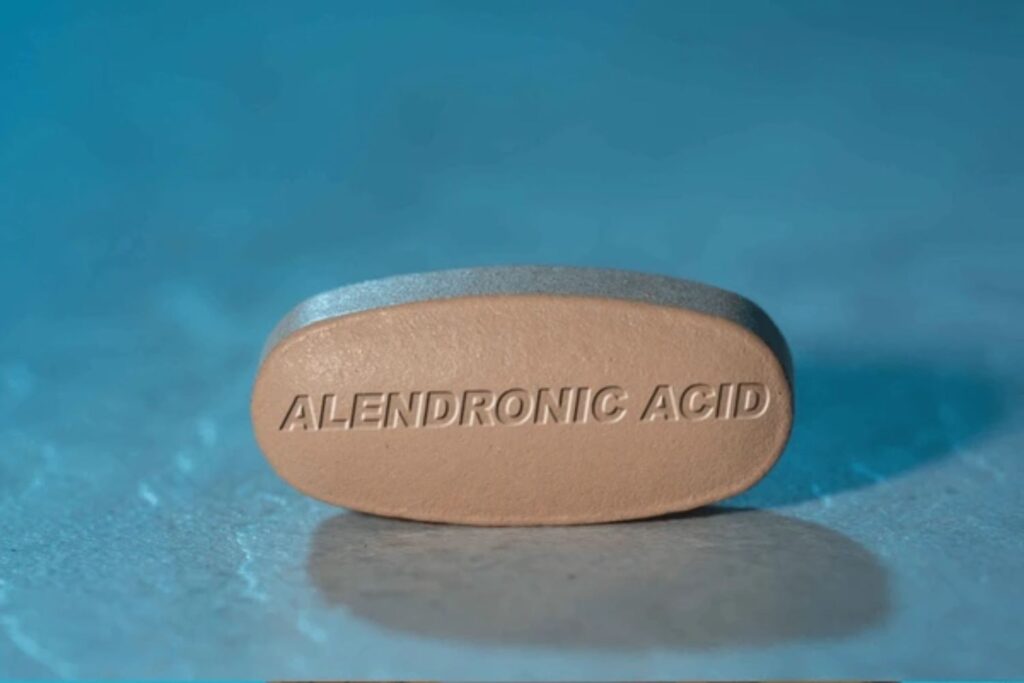
Alendronate stands as a cornerstone in the realm of bone health, a first – line bisphosphonate medication pivotal for combating osteoporosis and managing abnormal bone resorption. Tailored to slow bone breakdown, it strengthens skeletal structure, reducing fracture risks for postmenopausal women, patients on long – term steroids, and men grappling with bone loss. By inhibiting osteoclast activity—the cells that degrade bone—alendronate helps rebalance bone turnover, fostering stability in conditions like Paget’s disease too.
This article provides a comprehensive overview of alendronate’s pharmacological properties, clinical applications, and therapeutic advantages using PatSnap Eureka AI Agent.
What is Alendronate?
Alendronate is a nitrogen-containing bisphosphonate that acts by inhibiting bone resorption. First approved by the FDA in 1995 under the brand name Fosamax, it’s widely prescribed for:
- Osteoporosis in postmenopausal people
- Glucocorticoid-induced osteoporosis
- Paget’s disease of bone
- Osteogenesis imperfecta (off-label)
Alendronate works by binding to hydroxyapatite in bone and interfering with osteoclast activity, helping maintain or improve bone mineral density (BMD) and reducing the risk of fractures.

Key Characteristics of Alendronate
| Feature | Details |
|---|---|
| Drug Class | Bisphosphonate (nitrogen-containing) |
| Mechanism | Inhibits osteoclast-mediated bone resorption |
| FDA Approval | 1995 (as Fosamax) |
| Typical Half-Life in Bone | >10 years (due to incorporation into bone matrix) |
| Formulations | Oral tablets, effervescent tablets, once-weekly dosing options |
| Primary Use | Osteoporosis and related bone conditions |
Alendronate Sodium and Fosamax
Alendronate sodium is the active pharmaceutical ingredient (API) in several bisphosphonate medications used to treat osteoporosis and other bone-resorptive disorders. It is most commonly recognized under the brand name Fosamax, originally developed and marketed by Merck & Co. Fosamax was the first oral bisphosphonate approved for the prevention and treatment of postmenopausal osteoporosis.
While Fosamax remains a well-known brand, many generic formulations containing alendronate sodium are now widely available globally. These generics provide the same clinical efficacy and safety profile, often at a lower cost. Both branded and generic forms work by inhibiting osteoclast-mediated bone resorption and improving bone mineral density.
Key Forms and Formulations
Alendronate is available in several convenient formats, which enhance patient adherence:
- Tablets: 5 mg, 10 mg, 35 mg, 70 mg
- Oral Solution: 70 mg/75 mL for patients with swallowing difficulties
- Effervescent Tablets: For enhanced gastrointestinal tolerability
- Combination Products: Often combined with vitamin D (e.g., Fosamax Plus D)
Mechanism of Action
Alendronate, like other nitrogen-containing bisphosphonates, exerts its antiresorptive effect by targeting osteoclasts, the specialized cells responsible for bone breakdown. Its mechanism involves selective binding, intracellular inhibition, and induction of programmed cell death in these bone-resorbing cells.

Targeted Accumulation in Bone
After oral administration, alendronate is poorly absorbed in the gastrointestinal tract, with bioavailability of less than 1%. However, the portion that is absorbed has high affinity for hydroxyapatite crystals in bone tissue—specifically at sites of active bone remodeling.
- It binds tightly and becomes embedded in the bone matrix near osteoclast resorption lacunae, remaining there until bone is remodeled again.
- This localization allows alendronate to be selectively internalized by active osteoclasts during the bone resorption process.
Intracellular Enzyme Inhibition
Once inside osteoclasts, alendronate inhibits farnesyl pyrophosphate synthase (FPPS), a critical enzyme in the mevalonate pathway—a biosynthetic pathway required for producing isoprenoid lipids.
- These lipids are necessary for the prenylation (post-translational modification) of small GTP-binding proteins such as Ras, Rho, and Rac.
- These GTPases regulate cytoskeletal organization, membrane ruffling, vesicular trafficking, and cell survival—all essential functions for osteoclast activity.
Impairment of Osteoclast Function
By blocking FPPS and thus disrupting protein prenylation:
- Osteoclasts lose their ruffled border, which is essential for resorbing bone matrix.
- They exhibit cytoskeletal disorganization and loss of attachment to the bone surface.
- Their ability to secrete hydrogen ions and proteolytic enzymes into the resorption lacuna is impaired, directly halting bone degradation.
Induction of Apoptosis
In addition to functional impairment, alendronate triggers apoptosis (programmed cell death) in osteoclasts:
- Disruption of intracellular signaling and cytoskeletal integrity leads to activation of caspase pathways.
- As a result, osteoclast lifespan is shortened, reducing the number of bone-resorbing cells.
Overall Effect on Bone Turnover
Through these combined actions, alendronate:
- Suppresses bone resorption without directly affecting osteoblasts (bone-forming cells)
- Leads to a net increase in bone mineral density (BMD)
- Reduces bone turnover markers, including serum CTX and urinary NTX
- Significantly lowers fracture risk, particularly in the spine and hip
Clinical Uses
Postmenopausal Osteoporosis
Alendronate is most widely used to prevent and treat osteoporosis in postmenopausal women. Clinical studies show:
- Up to 50% reduction in vertebral fractures
- Increased BMD at the lumbar spine and femoral neck
Glucocorticoid-Induced Osteoporosis (GIOP)
Used to offset the bone-depleting effects of chronic corticosteroid therapy.
Paget’s Disease of Bone
Effective in normalizing serum alkaline phosphatase and reducing bone pain.
Osteopenia (at-risk populations)
Sometimes prescribed off-label in patients with low BMD and multiple risk factors.

Dosage and Administration
| Indication | Dosage | Frequency |
|---|---|---|
| Postmenopausal osteoporosis | 70 mg | Once weekly |
| Osteoporosis (daily) | 10 mg | Once daily |
| GIOP | 5–10 mg | Daily |
| Paget’s Disease | 40 mg | Daily for 6 months |
Administration Tips:
- Take with plain water at least 30 minutes before food or other medications
- Stay upright for at least 30 minutes after administration to avoid esophageal irritation
Side Effects and Safety
Common Adverse Effects
- GI symptoms: heartburn, nausea, abdominal pain
- Musculoskeletal pain
- Hypocalcemia (especially in vitamin D-deficient patients)
Serious or Rare Effects
- Esophagitis or esophageal ulceration
- Osteonecrosis of the jaw (ONJ) – rare, but more likely in oncology patients
- Atypical femoral fractures – linked to long-term use (>5 years)
Alendronate vs. Other Osteoporosis Drugs
| Drug | Mechanism | Administration | Notes |
|---|---|---|---|
| Alendronate | Inhibits osteoclasts via FPPS blockade | Oral, weekly/daily | First-line for many; affordable; long half-life |
| Risedronate | Similar to alendronate | Oral, daily/weekly | Slightly faster onset; less GI irritation |
| Denosumab | RANKL inhibitor | Subcutaneous, biannual | Reversible effect; immune-modulating risk |
| Teriparatide | Recombinant PTH analog | Daily injection | Anabolic (builds bone); used in severe cases |
| Romosozumab | Sclerostin inhibitor | Monthly injection | Dual action (anabolic + antiresorptive); expensive |

Conclusion
Alendronate remains a foundational therapy for osteoporosis and related bone diseases, with robust evidence supporting its efficacy in reducing fractures, improving BMD, and stabilizing bone turnover. Its oral availability, cost-effectiveness, and long-term safety make it a mainstay in clinical practice.
However, treatment duration must be individualized. Periodic reassessment—especially after 3 to 5 years—is crucial to avoid over-suppression of bone turnover.
For regulatory strategists and researchers, PatSnap Eureka AI Agent provides unmatched access to molecular data, real-world usage trends, safety updates, and IP filings—helping professionals make informed decisions around lifecycle management and clinical positioning of alendronate.
FAQs
Treats osteoporosis, and Paget’s disease of bone. Reduces fracture risk by strengthening bones.
Inhibits osteoclasts (cells that break down bone), slowing bone resorption. This balances bone turnover, preserving bone density/strength.
Avoid lying down soon after dosing (risk of esophageal irritation).
Don’t take with food, calcium, or antacids (reduces absorption).
Limit alcohol (worsens bone loss risk).
Long – term use debates: rare risks like atypical femur fractures, osteonecrosis of the jaw (ONJ), vs. benefits for high – fracture – risk patients. Balancing efficacy and safety sparks discussion.
To get more detailed scientific explanations of the alendronate, try PatSnap Eureka AI Agent.

